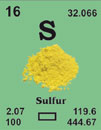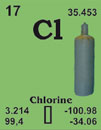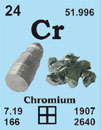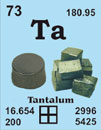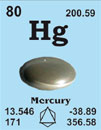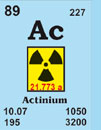Niobium 41Nb92.906
Discovered in 1801 by C. Hatchett at London, England.
[Greek, Niobe = daughter of Tantalus]
French: Niobium
German: Niob
Italian: Niobio
Spanish: Niobio
Description: Niobium is a shiny, silvery metal, which is soft when pure. It resists corrosion due to an oxide film on the surface. Niobium is attacked by hot, concentrated acids, but resists attack by alkalis, even when they are molten. Niobium is used in stainless steels.
Niobium single crystal properties
| State: |
single crystal |
|---|
| Crystal structure: |
bcc |
|---|
| Production method: |
Floating Zone |
|---|
| Standard size: |
diameter 8-12mm
thickness 1-2mm |
|---|
| Orientation: |
(100), (110) and (111) |
|---|
| Orientation accuracy: |
<2°, <1°, <0.4° or <0.1° |
|---|
| Polishing: |
as cut, one or two sides polished |
|---|
| Roughness of surface: |
<0.03µm |
|---|
| Purity: |
99.99% |
|---|
| Typical analysis (ppm): |
C 3
H < 1
O 9
N < 5
Cu 1.60
Fe 1.80
Ni < 1
Pb 0.30
Si 0.30
Ga, Hf and Ta are below the detection limit
|
|---|
Materials properties
| Density: |
8.4 g/cm3 |
|---|
| Melting point: |
2467.85 °C / 2741 °K |
|---|
| Boiling point: |
4741.85 °C / 5015 °K |
|---|
| Molar volume: |
10.84 cm3 |
|---|
| Thermal conductivity: |
53.7 [300 K] Wm-1K-1 |
|---|
| Coefficient of linear thermal expansion: |
7.07 x 10-6 K-1 |
|---|
| Electrical resistivity: |
12.5x 10-8 [273 K] Wm |
|---|
| Mass magnetic susceptibility: |
+2.76 x 10-8(s) kg-1m3 |
|---|
| Young's modulus: |
104.9 GPa |
|---|
| Rigidity modulus: |
37.5 GPa |
|---|
| Bulk modulus: |
170.3 GPa |
|---|
| Poisson's ratio: |
0.397 |
|---|
| Radii: |
Nb5+ 69; Nb4+ 74; atomic 143; covalent 134 |
|---|
| Electronegativity: |
1.6 (Pauling); 1.23 (Allred); 4.0 eV (absolute) |
|---|
| Effective nuclear charge: |
3.30 (Slater); 6.70 (Clementi); 9.60 (Froese-Fischer) |
|---|
| Number of Isotopes (incl. nuclear isomers): |
31 |
|---|
| Issotope mass range: |
86 -> 103 |
|---|
| Crystal structure, (cell dimentions / pm), space group |
bcc |
|---|
| X-ray diffraction: mass absorption coefficients: |
CuKα 153 (µ/r) / cm2g-1
MoKα 17.1 (µ/r) / cm2g-1 |
|---|
| Neutron scattering length: |
0.7054 b/10-12 cm |
|---|
| Thermal neutron capture cross-section: |
1.15 sa / barns |
|---|
Biological data
| Biological role: |
none |
|---|
| Toxicity |
|
|---|
| Toxic intake: |
n.a. |
|---|
| Lethal intake: |
LD50 (chloride, oral, rat)= 1500 mg kg-1 |
|---|
| Hazards: |
Niobium and its compounds may be toxic but there are no reports of humans beeing poisoned. Niobium dust causes eye and skin irritation. |
|---|
| Level in humans |
|
|---|
| Blood: |
0.005 mg dm-3 |
|---|
| Bone: |
<0.07 p.p.m. |
|---|
| Liver: |
0.14 p.p.m. |
|---|
| Muscle: |
0.14 p.p.m. |
|---|
| Daily dietary intake: |
0.02 - 0.6 mg |
|---|
| Total mass of element in average [70 kg] person: |
< 1.5 mg |
|---|
Geological data
| Mineral | Formula | Density | Hardness | Crystal apperance |
|---|
| Betafite |
(Ca, U)2(Ti, Nb, Ta)2O6(OH) |
4.5 |
4 - 5.5 |
cub., waxy/vit. black/greenish |
|---|
| Columbite |
(Fe, Mn)(Nb, Ta)2O6 |
varies |
c. 6 |
orth., opaque sub.met. lustre |
|---|
| Fergusonite |
YNbO4) |
5.7 |
5.5 - 6.5 |
tet., vitreous, sub-met. black |
|---|
| Samarskite |
(Y, Ce, U, Fe)3(Nb, Ta, Ti)5O16 |
5.69 |
5 - 6 |
orth., vitreous/resinous black |
|---|
| Chief ore: |
columbite, samarskite, betafite; obtained as a by-product of tin-extraction. |
|---|
| World production: |
15 000 tonnes/year |
|---|
| Main mining areas: |
Australia, Zaire, Brazil, Russia, Norway, Canada, Madagascar |
|---|
| Reserves: |
n.a. |
|---|
| Specimen: |
available as foil, powder, rod, turnings or wire. Safe. |
|---|
| Abundances |
|
|---|
| Sun: |
79 (relative to H = 1 x 1012) |
|---|
| Earth's crust: |
20 p.p.m. |
|---|
| Seawater: |
|
|---|
| Residence time: |
|
|---|
| Classification: |
|
|---|
| Oxidation state: |
V |
|---|
Source: Emsley, J. (1998) The Elements (3rd Edition)

 English
English
 Deutsch
Deutsch
















